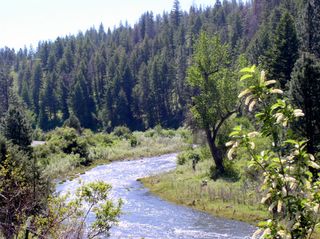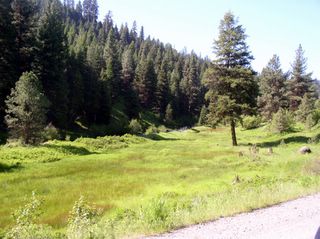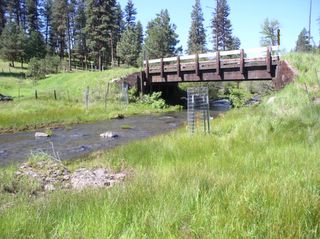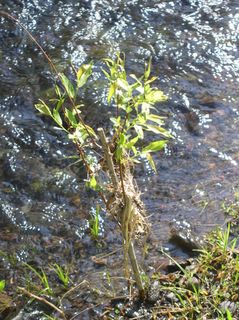Oregon Trout Habitat Restoration
This past Memorial Day (2005) I drove 6 hours to eastern Oregon to the Middle Fork of the John Day River for a weekend of stream habitat restoration with Oregon Trout. Redington and I did this last year as well and with a group of 15-20 people planted some 5000 trees. We did most of our work on the Camp Creek tributary of the Middle Fork and on Lick Creek a tributary of Camp Creek and Long Creek at Flood Meadow.
Oregon Trout has been involved for the last 3-4 years on this section which the forest service (Malhuer National Forest), ODFW (Oregon Division of Fish and Wildlife) and NOAA (National Oceanographic and Atmospheric Administration) highlighted as significant habitat for the Steelhead an andronamous member of the trout family which means like salmon they swim upstream from the ocean to spawn. Unlike salmon though steelhead may return to spawn many times in their lifetimes. Nevertheless they are a threatened species and hence the subject of intense efforts to restore their populations.
The biggest impact to the area's habitats over the past 150 years has been ranching, logging, and placer mining.

Camp Creek is seen here at its high water point. By the end of summer it will be reduced to a trickle. Until about 20 years ago cattle had unrestricted grazing in the riparian zone which has stripped the stream bank of its vegetation. This is believed to be detrimental to steelhead in reducing shade. A logging raliroad bed has channelized the stream bed reducing meanders and undercut stream banks that provide shelter in hot low water days of late summer for juvenile steelhead.

Camp Creek in another view shows how lush the vegetation is after the previous two weeks heavy range. The following week of my visit cattle were to be put on the range. Fortunately most of the senistive riparian areas are fenced to keep cattle away. Many of these fences were buitl as part of collaborative effort between the Long Creek grazing association an Oregon Trout.

Here are examples of some cages we built. These are placed over planting we did last year (indeed these are some that Redington and I did last year). We drive in T-posts (not easy in this rocky soil) then measure cut and tie a loop of fence to the posts. This protects the planting from deer and elk until they get to a robust size.

This is one willow tree that Redington and I planted last year. It starts out as just a stick which must be put 12-18 inches into the soil. This year it is already sprouting branches. Redington was skeptical that mere sticks would actually live. He was impressed when I brought the photos back this year to show his hard work was worth it.

Modesty Spring was a side trip. There is a tradition around Long Creek that you are not a Long Creeker until you have drank from Modesty Spring. It must be understood this remarkable spring which issues form a hole in a rock is only known by this name on Forest Service maps. It is better known locally as Pu**y Spring owing to its unique shape. The water is slightly warmer than the stream water and very sulphurous. This I suppose makes it a kind of Grant county Oregon version of the Blarney stone.
Next month Redington and I plan to attend the 'ethnic cleansing' operation. Really just removing non-native Brook trout from canyon creek to allow the indiginous species to thrive. This is done by electrocuting the fish to stun them, netting them all, and then returning the non-Brook trout to the river. The Brook trout are given to charitable organizations for food.
Oregon Trout has been involved for the last 3-4 years on this section which the forest service (Malhuer National Forest), ODFW (Oregon Division of Fish and Wildlife) and NOAA (National Oceanographic and Atmospheric Administration) highlighted as significant habitat for the Steelhead an andronamous member of the trout family which means like salmon they swim upstream from the ocean to spawn. Unlike salmon though steelhead may return to spawn many times in their lifetimes. Nevertheless they are a threatened species and hence the subject of intense efforts to restore their populations.
The biggest impact to the area's habitats over the past 150 years has been ranching, logging, and placer mining.

Camp Creek is seen here at its high water point. By the end of summer it will be reduced to a trickle. Until about 20 years ago cattle had unrestricted grazing in the riparian zone which has stripped the stream bank of its vegetation. This is believed to be detrimental to steelhead in reducing shade. A logging raliroad bed has channelized the stream bed reducing meanders and undercut stream banks that provide shelter in hot low water days of late summer for juvenile steelhead.

Camp Creek in another view shows how lush the vegetation is after the previous two weeks heavy range. The following week of my visit cattle were to be put on the range. Fortunately most of the senistive riparian areas are fenced to keep cattle away. Many of these fences were buitl as part of collaborative effort between the Long Creek grazing association an Oregon Trout.

Here are examples of some cages we built. These are placed over planting we did last year (indeed these are some that Redington and I did last year). We drive in T-posts (not easy in this rocky soil) then measure cut and tie a loop of fence to the posts. This protects the planting from deer and elk until they get to a robust size.

This is one willow tree that Redington and I planted last year. It starts out as just a stick which must be put 12-18 inches into the soil. This year it is already sprouting branches. Redington was skeptical that mere sticks would actually live. He was impressed when I brought the photos back this year to show his hard work was worth it.

Modesty Spring was a side trip. There is a tradition around Long Creek that you are not a Long Creeker until you have drank from Modesty Spring. It must be understood this remarkable spring which issues form a hole in a rock is only known by this name on Forest Service maps. It is better known locally as Pu**y Spring owing to its unique shape. The water is slightly warmer than the stream water and very sulphurous. This I suppose makes it a kind of Grant county Oregon version of the Blarney stone.
Next month Redington and I plan to attend the 'ethnic cleansing' operation. Really just removing non-native Brook trout from canyon creek to allow the indiginous species to thrive. This is done by electrocuting the fish to stun them, netting them all, and then returning the non-Brook trout to the river. The Brook trout are given to charitable organizations for food.
Comments